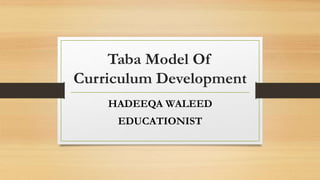Taba model of curriculum development
The Taba Model was developed by Hilda Taba (1902 - 1967), an architect, a curriculum theorist, a curriculum reformer, and a teacher educator.Taba believed that there has to be a definite order in creating a curriculum. She advocated that teachers take an inductive approach to curriculum development which meant starting with the specifics and building toward a general design, rather than the traditional deductive approach (starts with the general design and work towards the specifics) which was rooted in Tyler's model. Hilda Taba followed the grass-roots approach in developing curriculum For her, it should be the teachers who should design the curriculum rather than the higher authorities (Oliva, 1992). More specifically stated, the Taba approach believes in allowing the curriculum to be developed and/or authored by the users (teachers). Under the Taba Model teachers are expected to begin each curriculum by creating specific teaching-learning units and building to a general design. According to Khwaja, Akhtar, & Mirza (n.d.), "the Taba model was an attempt to ensure that decisions about curriculum are made on the basis of valid criteria and not whim or fancy." Her model of developing a curriculum consisted of seven main steps and over the years, these seven steps have formed the basis for Hilda Taba's ... This solution provides information about Hilda Taba and her suggested approach to curriculum development. It also includes information about five of Taba's main elements required when developing a curriculum. The solution is referenced. Diagnosis of needs Formulation of learning objectives Selection of learning content Organization of learning content Selection of learning experiences Organization of learning activities Evaluation and means of evaluation

Recommended
Recommended
More Related Content
What's hot
What's hot (20)
Similar to Taba model of curriculum development
Similar to Taba model of curriculum development (20)
More from HadeeqaTanveer
More from HadeeqaTanveer (20)
Recently uploaded
Recently uploaded (20)
Taba model of curriculum development
- 1. Taba Model Of Curriculum Development HADEEQA WALEED EDUCATIONIST
- 2. The Taba Model • The Taba Model was developed by Hilda Taba (1902 - 1967), an architect, a curriculum theorist, a curriculum reformer, and a teacher educator. She was born in the small village of Kooraste, Estonia. Taba believed that there has to be a definite order in creating a curriculum.
- 3. • She advocated that teachers take an inductive approach to curriculum development which meant starting with the specifics and building toward a general design, rather than the traditional deductive approach (starts with the general design and work towards the specifics) which was rooted in Tyler's model. Hilda Taba followed the grass-roots approach in developing curriculum
- 4. • For her, it should be the teachers who should design the curriculum rather than the higher authorities (Oliva, 1992). More specifically stated, the Taba approach believes in allowing the curriculum to be developed and/or authored by the users (teachers). Under the Taba Model teachers are expected to begin each curriculum by creating specific teaching- learning units and building to a general design.
- 5. • According to Khwaja, Akhtar, & Mirza (n.d.), "the Taba model was an attempt to ensure that decisions about curriculum are made on the basis of valid criteria and not whim or fancy." Her model of developing a curriculum consisted of seven main steps and over the years, these seven steps have formed the basis for Hilda Taba's ...
- 6. •This solution provides information about Hilda Taba and her suggested approach to curriculum development. It also includes information about five of Taba's main elements required when developing a curriculum. The solution is referenced.
- 7. THE SEVEN STEPS OF HILDA TABA’S MODEL: • Diagnosis of needs • Formulation of learning objectives • Selection of learning content • Organization of learning content • Selection of learning experiences • Organization of learning activities • Evaluation and means of evaluation
- 8. . DIAGNOSIS OF NEEDS •The teacher (curriculum designer) starts the process by identifying the needs of the students for whom the curriculum is to be planned
- 9. FORMULATION OF LEARNING OBJECTIVES •After the teacher has identified the needs that require attention, he or she specifies objectives to be accomplished.
- 10. SELECTION OF LEARNING CONTENT • The objectives selected or created suggest the subject matter or content of the curriculum. Not only should objectives and content match but also the validity and significance of the content chosen needs to be determined.
- 11. ORGANIZATION OF LEARNING CONTENT • A teacher can not just select content, but must organize it in some type of sequence, taking into consideration the maturity of the learners, their academic achievement, and their interests.
- 12. SELECTION OF LEARNING EXPERIENCES • Content must be presented to pupils and pupils must engage the content. At this point, the teacher select instructional methods that will involve students with the content.
- 13. ORGANIZATION OF LEARNING ACTIVITIES • Just as content must be sequenced and organized, so must the learning activities. Often the sequence of the learning activities is determined by the content. But the teacher needs to keep in mind the particular students whom he or she will be teaching
- 14. EVALUATION AND MEANS OF EVALUATION •The curriculum planner must determine just what objectives have been accomplished. Evaluation procedures need to be considered by the students and teachers.